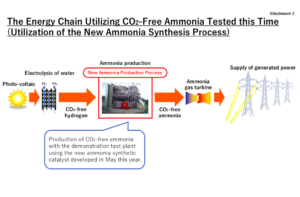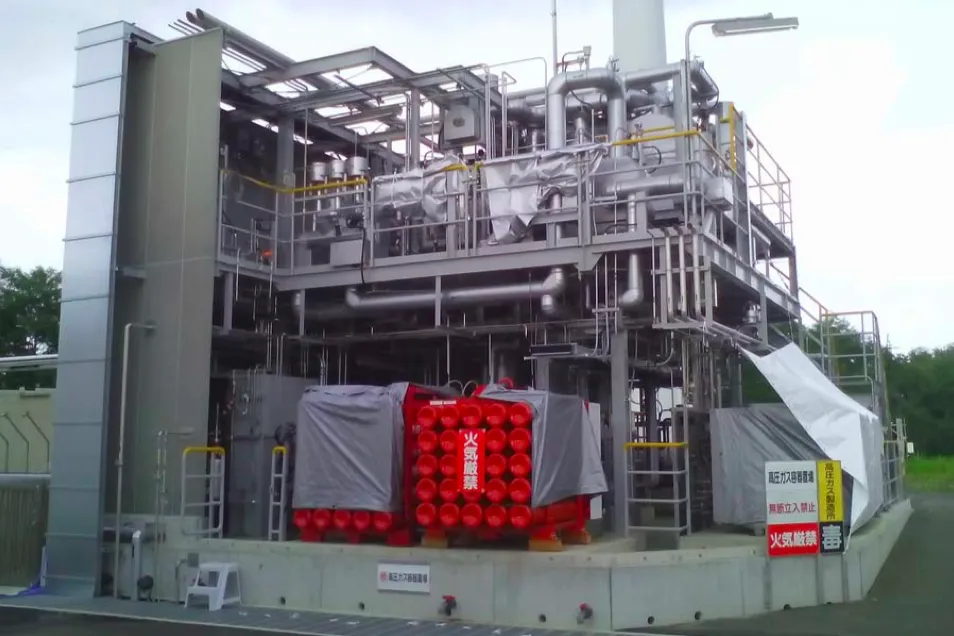JGC Corporation demonstrates “world’s first” carbon-free ammonia energy cycle
By Trevor Brown on January 04, 2019

In late 2018, JGC Corporation issued a press release to celebrate a “world’s first” in ammonia energy, demonstrating at its pilot plant in Koriyama both “synthesis of ammonia with hydrogen produced through the electrolysis of water by renewable energy, and generation of electricity through gas turbines fueled by synthesized ammonia.”
By demonstrating the feasibility of using ammonia on both sides of the renewable energy equation — first, producing green ammonia from intermittent renewable electricity and, second, combusting this carbon-free fuel for power generation — the project demonstrates the role of ammonia in the “establishment of an energy chain … that does not emit CO2 (CO2-free) from production to power generation.”

The project is part of the Japanese Science and Technology Agency’s SIP “Energy Carriers” project, and I have previously written about its original scope (Low-carbon ammonia synthesis: Japan’s ‘Energy Carriers’ R&D, in November 2016) and the initial start-up of operations at the plant (Green ammonia pilot plants now running, in Oxford and Fukushima, in June 2018). Since then, much more information has been published about the project, including JGC’s announcements and a series of papers given at the Ammonia Energy Association’s annual conference in October 2018.
At the core of this project is an ammonia synthesis catalyst optimized for the operating conditions expected when making ammonia from hydrogen produced by electrolyzers using renewable power: lower pressure and lower temperature, which enable fast and frequent ramping up and down to match the availability of intermittent wind or solar power inputs.
In May [2018], JGC, together with the AIST and the National Institute of Technology, Numazu College, as well as our subsidiary, JGC Catalysts & Chemicals Ltd., achieved success in development of a new ruthenium catalyst capable of efficiently synthesizing ammonia at a low temperature and low pressure through improvement of carrier and catalyst production methods using catalysts.
The JGC began operation of a demonstration plant (capable of producing ammonia at the rate of 20 kg per day) … Through this demonstration plant, together with confirming the high activity at a low temperature and pressure of the newly developed catalyst, the JGC Group verified the enabling of a change in ammonia production volume through rapid operational condition changes when using renewable energy …
JGC Group tested synthesis of ammonia using hydrogen produced through electrolysis of water through power generated by solar power equipment installed on the same premises, and realized a demonstration plant (power generation: 47 kW) through gas turbines fueled by synthesized ammonia.
JGC Corporation, World’s First Successful Ammonia Synthesis Using Renewable Energy-Based Hydrogen and Power Generation, 10/18/2018

At the NH3 Energy+ Topical Conference, within the AIChE Annual Meeting at the end of October 2018, Hideyuki Matsumoto from the Renewable Energy Research Center at the National Institute of Advanced Industrial Science and Technology (AIST) presented detailed technical information about the ruthenium catalyst development and testing. His presentation, Analysis of influence of operating pressure on dynamic behavior of ammonia production over ruthenium catalyst under high pressure condition, is available to download at the Ammonia Energy Association website.

Another presentation at the NH3 Energy+ Topical Conference was by JGC Corporation’s Mototaka Kai, who presented an overview of the company’s Demonstration of CO2-Free Ammonia Synthesis Using Renewable Energy-Generated Hydrogen. In his presentation, Kai described the next two steps in the ongoing research.

The first step will be to test plant and catalyst operation under fluctuating conditions, “simulating variable renewable energy.” This will confirm both the “Ru Catalyst high activity under feed gas flowrate rapid increase / decrease,” and the “ammonia plant operation flexibility (allowable turn down range).”
Next, “in the near future,” JGC will perform a “commercial scale plant design and cost study,” defining the roadmap for deployment of renewable ammonia production plants.
The JGC announcement described broader ambitions for its green ammonia demonstration.
First, “JGC Group will continue to carry out the ammonia synthesis test and research and development toward cost reduction of ammonia.” This will be crucial innovation, driving down the costs of green ammonia so that it becomes increasingly competitive against conventional fossil ammonia. A key challenge will be to overcome efficiencies of scale, whereby distributed ammonia plants, scaled down to match renewable power inputs, can compete with centralized plants, whose technology has been scaled up over decades to match fossil inputs.

Beyond raw cost, however, JGC is “actively working toward energy diversification and realizing a low-carbon society,” building a supply chain for carbon-free energy based on ammonia. Japan is an energy importer, heavily reliant upon other nations for its power, and Japanese corporations have the motivation for this calibre of research and development because they place a value on realizing broader market and social innovation. These industrial investments are guided and supported by the government, for example, through the Hydrogen Basic Strategy enacted by Prime Minister Abe in December 2017.
Finally, driving the economics behind all this research and development is the perceived first-mover advantage for Japanese companies, not just in developing carbon-free technologies for deployment within Japan but also exporting those technologies and the operational know-how that comes from these demonstrations. That is the vision of the SIP Energy Carriers project: “Japan creating an innovative low-carbon, hydrogen-fueled economy and taking the lead in hydrogen related industries on the world market.”
You can also read the full article at AmmoniaIndustry.com.